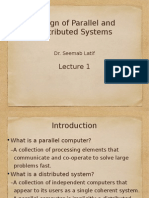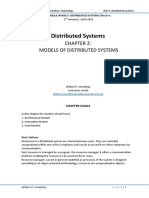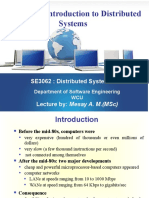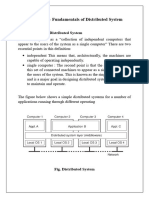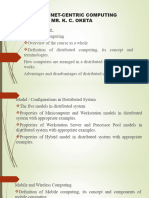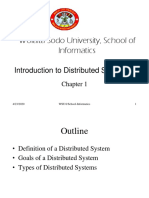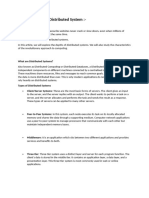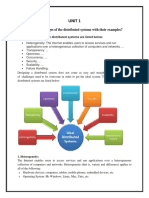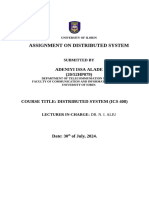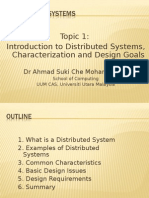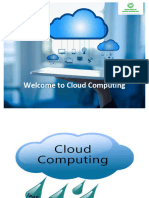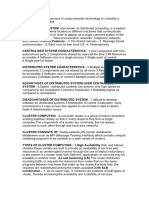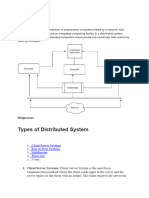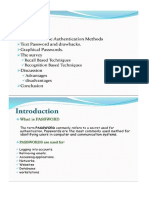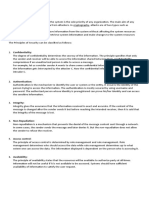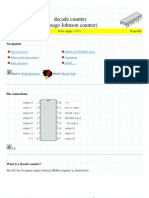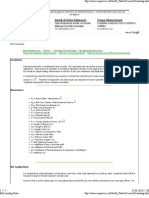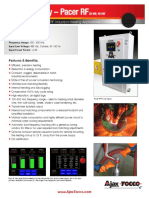Chapter 1 Distributed Systems Basic Issues
Chapter 1 Distributed Systems Basic Issues
Uploaded by
Belle SebullenCopyright:
Available Formats
Chapter 1 Distributed Systems Basic Issues
Chapter 1 Distributed Systems Basic Issues
Uploaded by
Belle SebullenCopyright
Available Formats
Share this document
Did you find this document useful?
Is this content inappropriate?
Copyright:
Available Formats
Chapter 1 Distributed Systems Basic Issues
Chapter 1 Distributed Systems Basic Issues
Uploaded by
Belle SebullenCopyright:
Available Formats
UA –Main Campus-BS Information Technology NAS 5: Distributed Systems
MODULE IN NAS 5: DISTRIBUTED SYSTEM
Effective: 1ST Semester, 2020-2021
Distributed Systems
CHAPTER 1:
Distributed Systems Basic Issues
Wilbert P. Umadhay
Instructor email:
Wilbert.Umadhay@antiquespride.edu.ph
CHAPTER GOALS
In this chapter the student should learn:
1. What is a Distributed System?
2. Advantages and Disadvantages
3. Design Issues with Distributed Systems
Lesson 1: What is a Distributed System?
A distributed system is a collection of autonomous computers linked by a computer
network that appear to the users of the system as a single computer.
System architecture: the machines are autonomous; this means they are computers which,
in principle, could work independently;
The user’s perception: the distributed system is perceived as a single system solving a
certain problem (even though, in reality, we have several computers placed in different
locations).
Wilbert P. Umadhay Page1|9
UA –Main Campus-BS Information Technology NAS 5: Distributed Systems
By running a distributed system software, the computers are enabled to:
- coordinate their activities
-share resources: hardware, software, data.
Examples of Distributed Systems
In this system. the computer network connects several computer workstations with special
software forming a cluster, to act as a distributed supercomputer on a building-wide scale. -
Single file system, with all files accessible from all machines in the same way and using the
same path name.
-For a certain command the system can look for the best place (workstation) to execute it.
In this system, the system consist of a server and some Automated Teller Machines(ATM).
The server manages all users’ account information.
Primary requirements of Banking systems:
-Security and reliability.
-Consistency of replicated data.
Wilbert P. Umadhay Page2|9
UA –Main Campus-BS Information Technology NAS 5: Distributed Systems
-Concurrent transactions (operations which involve accounts in different banks,
simultaneous access from several users, etc).
-Fault tolerance
The Cloud and Internet of Things (IoT) in Distributed Systems represent a vision in which the
internet extends into the real world embracing everyday objects. Physical items are no
longer disconnected from the virtual world, but can be remotely controlled and can act as
physical access points to the internet service.
-Computing as a utility: application, storage, computing services; pay on per-usage basis. -
Main concerns: scaling, performance, security/reliability.
For safety critical-physical systems such as automotive systems, absolute guarantee of
timely behavior is crucial. In modern automotive systems that can support real-time
Wilbert P. Umadhay Page3|9
UA –Main Campus-BS Information Technology NAS 5: Distributed Systems
applications, distributed architectures are commonly used, where vehicles are connecter
in a complex network system Distributed Real-Time Systems
-Synchronization of physical clocks
-Scheduling with hard time constraints
-Real-time communication
-Fault tolerance
Lesson 2: Why do we Need Distributed Systems?
Advantages of Distributed Systems
Performance: very often a collection of processors can provide higher performance (and
better price/performance ratio) than a centralized computer.
Distribution: many applications involve, by their nature, spatially separated machines
(banking, commercial, automotive system).
Reliability (fault tolerance): if some machine crashes, the system can survive.
Incremental growth: as requirements on processing power grow, new machines can be
added incrementally.
Sharing of data/resources: shared data is essential to many applications (banking,
computer-supported cooperative work, reservation systems); other resources can be also
shared (e.g. expensive printers).
Communication: facilitates human-to-human communication.
Disadvantages of Distributed Systems
Difficulties of developing distributed software: how should operating systems,
programming languages and applications look like?
Networking problems: several problems are created by the network infrastructure, which
have to be dealt with: loss of messages, overloading,
Security problems: sharing generates the problem of data security.
Lesson 3: Design Issues with Distributed Systems
Issues that arise specifically from the distributed nature of the application:
Wilbert P. Umadhay Page4|9
UA –Main Campus-BS Information Technology NAS 5: Distributed Systems
• Transparency
• Communication
• Performance & Scalability
• Heterogeneity
• Openness
• Reliability & Fault tolerance
• Security
Transparency
Transparency is defined as the concealment from the user and the application programmer
of the separation of components in a distributed system, so that the system is perceived as
a whole rather than as a collection of independent components. The implications of
transparency are a major influence on the design of the system software.
Access transparency enables local and remote resources to be accessed using identical
operations.
Location transparency enables resources to be accessed without knowledge of their
physical or network location (for example, which building or IP address).
Concurrency transparency enables several processes to operate concurrently using shared
resources without interference between them.
Replication transparency enables multiple instances of resources to be used to increase
reliability and performance without knowledge of the replicas by users or application
programmers.
Failure transparency enables the concealment of faults, allowing users and application
programs to complete their tasks despite the failure of hardware or software components.
Mobility transparency allows the movement of resources and clients within a system
without affecting the operation of users or programs.
Performance transparency allows the system to be reconfigured to improve performance as
loads vary.
Scaling transparency allows the system and applications to expand in scale without change
to the system structure or the application algorithms.
Communication
Components of a distributed system have to communicate in order to interact.
This implies support at two levels:
1. Networking infrastructure (interconnections & network software).
2. Appropriate communication primitives and models:
Wilbert P. Umadhay Page5|9
UA –Main Campus-BS Information Technology NAS 5: Distributed Systems
Communication primitives:
- send
- receive
- remote procedure call (RPC)
Communication models
- Client-server communication: implies a message exchange between two processes: the
process which requests a service and the one which provides it;
- Group multicast: the target of a message is a set of processes, which are members of a
given group.
Performance and Scalability Performance
Several factors are influencing the performance of a distributed system:
-The performance of individual workstations.
-The speed of the communication infrastructure.
-Extent to which reliability (fault tolerance) is provided (replication and preservation of
coherence imply large overheads).
-Flexibility in workload allocation: for example, idle processors (workstations) could be
allocated automatically to a user’s task.
Scalability
The system should remain efficient even with a significant increase in the number of users
and resources connected:
-cost of adding resources should be reasonable;
-performance loss with increased number of users and resources should be controlled;
-software resources should not run out (number of bits allocated to addresses, number of
entries in tables, etc.)
Heterogeneity
When event notifications are used as a means of communication, components in a
distributed system that were not designed to interoperate can be made to work together.
Distributed applications are typically heterogeneous:
-different hardware: mainframes, workstations, PCs, servers, etc.
-different software: UNIX, MS Windows, IBM OS/2, Real-time OSs, etc.
-unconventional devices: teller machines, telephone switches, robots, manufacturing
systems, etc.
-diverse networks and protocols: Ethernet, FDDI, ATM, TCP/IP, Novell Netware, etc.
The solution:
Middleware, an additional software layer to mask heterogeneity.
Openness
One important feature of distributed systems is openness and flexibility:
Wilbert P. Umadhay Page6|9
UA –Main Campus-BS Information Technology NAS 5: Distributed Systems
-every service is equally accessible to every client (local or remote); it is easy to implement,
install and debug new services;
-users can write and install their own services.
Key aspect of openness:
-Standard interfaces and protocols (like Internet protocols)
-Support of heterogeneity (by adequate middleware, like CORBA)
Reliability and Fault Tolerance
One of the main goals of building distributed systems is improved reliability.
Availability: If machines go down, the system should work with the reduced amount of
resources.
-There should be a very small number of critical resources (single points of failure);
-critical resources: resources which have to be up in order the distributed system to work.
-Key pieces of hardware and software (critical resources) should be replicated if one of them
fails another one takes up - redundancy.
-Data on the system must not be lost, and copies stored redundantly on different servers
must be kept consistent.
-The more copies kept, the better the availability, but keeping consistency becomes more
difficult.
-Reliable systems need to have a high degree of availability; in order to achieve this, they
need to be fault tolerant.
Fault tolerance
The system has to detect faults and act in a reasonable way:
-mask the fault: continue to work with possibly reduced performance but without loss of
data/information.
-fail gracefully: react to the fault in a predictable way and possibly stop functionality for a
short period, but without loss of data/information.
Security
Security of information resources implies:
1. Confidentiality - Protection against disclosure to unauthorized person
2. Integrity - Protection against alteration and corruption
3. Availability - Keep the resource accessible
Wilbert P. Umadhay Page7|9
UA –Main Campus-BS Information Technology NAS 5: Distributed Systems
Reference: George Coulouris, Jean Dollimore, Tim Kindberg, Gordon Blair: "Distributed
Systems - Concepts and Design", Addison Wesley Publ. Comp., 5th edition, 2011.
Wilbert P. Umadhay Page8
UA –Main Campus-BS Information Technology NAS 5: Distributed Systems
| 10
Wilbert P. Umadhay Page9
You might also like
- MSI GP62MVR 6RF Leopard Pro MS-16JB - MS-179B MS-16JB1 Rev 1.0 (0A) СхемаDocument71 pagesMSI GP62MVR 6RF Leopard Pro MS-16JB - MS-179B MS-16JB1 Rev 1.0 (0A) СхемаРоман НиколаевNo ratings yet
- EHSx - PDSX - BGS5 - Updating Firmware AN16 V02 (17.12.2014) PDFDocument23 pagesEHSx - PDSX - BGS5 - Updating Firmware AN16 V02 (17.12.2014) PDFEug. Sam.100% (1)
- Manual de Partes MT4400 MH565 A MH570Document1,042 pagesManual de Partes MT4400 MH565 A MH570Hugo Estrada100% (2)
- Hand-Held Digital Multimeter: GDM-394/396 (3 Digits) GDM-356 (3 Digits) GDM-350A (3 Digits) GDM-451 (4 Digits)Document2 pagesHand-Held Digital Multimeter: GDM-394/396 (3 Digits) GDM-356 (3 Digits) GDM-350A (3 Digits) GDM-451 (4 Digits)javiefranNo ratings yet
- Design of Parallel and Distributed Systems: Dr. Seemab LatifDocument36 pagesDesign of Parallel and Distributed Systems: Dr. Seemab LatifNadi YaqoobNo ratings yet
- Introduction To Distributed SystemsDocument25 pagesIntroduction To Distributed SystemsshabinmohdNo ratings yet
- Distributed Processing SystemsDocument5 pagesDistributed Processing SystemsVincent John Agustin AlipioNo ratings yet
- Chapter 1Document117 pagesChapter 1snekarki80No ratings yet
- Week 1Document22 pagesWeek 1samuelsilas123456789No ratings yet
- Chapter 2 MODELS OF DISTRIBUTED SYSTEMSDocument7 pagesChapter 2 MODELS OF DISTRIBUTED SYSTEMSBelle SebullenNo ratings yet
- Unit 3 Introduction To Distributed SystemsDocument35 pagesUnit 3 Introduction To Distributed SystemsHariniNo ratings yet
- Distributed SystemsDocument10 pagesDistributed SystemsARBAZ KHANNo ratings yet
- Introduction To Distributed SystemsDocument5 pagesIntroduction To Distributed SystemsoljiraaNo ratings yet
- 01 - Introduction To Distributed SystemsDocument5 pages01 - Introduction To Distributed SystemsPeterArnoldNo ratings yet
- Flynn's Classification Divides Computers Into Four Major Groups That AreDocument44 pagesFlynn's Classification Divides Computers Into Four Major Groups That Are19 701 HARIHARAN SNo ratings yet
- Chapter 1 - IntroductionDocument44 pagesChapter 1 - Introductionchernet lukasNo ratings yet
- Chapter 1 IntroductionDocument73 pagesChapter 1 Introductionbirhanualemayehu185No ratings yet
- DS Unit-1Document31 pagesDS Unit-1ambatipudi praisy prasannaNo ratings yet
- CSC - 406 - 1 - Intro To Distributed SystemDocument22 pagesCSC - 406 - 1 - Intro To Distributed SystemSamadNo ratings yet
- DSGC 2020 Notes UNIT-1 PDFDocument12 pagesDSGC 2020 Notes UNIT-1 PDFAniket PiseNo ratings yet
- What Is A Distributed System ??Document8 pagesWhat Is A Distributed System ??svakinkNo ratings yet
- Session 1-Introduction-VFDocument7 pagesSession 1-Introduction-VFmoudouNo ratings yet
- Chapter 1-Introduction To Distributed SystemsDocument59 pagesChapter 1-Introduction To Distributed SystemsHiziki TareNo ratings yet
- Distributed ComputingDocument40 pagesDistributed Computing014 CSE Devamruth AGNo ratings yet
- Distributed S Notes 240228 144257Document69 pagesDistributed S Notes 240228 144257Victor KirimiNo ratings yet
- Distributed System IMP APYDocument210 pagesDistributed System IMP APYAryan PanchalNo ratings yet
- Chapter 1-IntroductionDocument60 pagesChapter 1-Introductionasmamaw damteNo ratings yet
- CSCE455/855 Distributed Operating Systems: Dr. Ying Lu Schorr Center 106Document41 pagesCSCE455/855 Distributed Operating Systems: Dr. Ying Lu Schorr Center 106mahawerNo ratings yet
- Dsunit 1 PART2Document28 pagesDsunit 1 PART2negianuj070No ratings yet
- Class NotesDocument36 pagesClass NotesGentiyal BhumiNo ratings yet
- CSC 421 Course Outline and IntroductionDocument22 pagesCSC 421 Course Outline and IntroductionikedichimoNo ratings yet
- PPPDocument4 pagesPPPJames ComedianNo ratings yet
- CHAPTER1 UpdateDocument20 pagesCHAPTER1 Updatemd5fxz9thsNo ratings yet
- 196 - Cahpter 1 - Characterization of DSsDocument10 pages196 - Cahpter 1 - Characterization of DSsAwoke AdaneNo ratings yet
- Introduction To Distributed SystemsDocument45 pagesIntroduction To Distributed Systemsaderaj getinetNo ratings yet
- Distributed Systems REPORTDocument39 pagesDistributed Systems REPORTClaudette Lui Cabanos- Mercado-ReyesNo ratings yet
- Chapter-1 Introduction To Distributed SystemDocument68 pagesChapter-1 Introduction To Distributed SystemGUTAMA KUSSE GELEGLONo ratings yet
- 555 PGDocument49 pages555 PGbivakarmahapatra7872No ratings yet
- Distributed Systems ReportDocument36 pagesDistributed Systems ReportClaudette Lui Cabanos- Mercado-Reyes100% (1)
- Ch. 3 ... Part - 5Document21 pagesCh. 3 ... Part - 5ketan soniNo ratings yet
- unit 1Document28 pagesunit 1storytimess111No ratings yet
- 03-Real Time and Distributed Computing Systems - 4paginasDocument4 pages03-Real Time and Distributed Computing Systems - 4paginasespinheirontNo ratings yet
- CH 1 Distributed SystemDocument12 pagesCH 1 Distributed Systemlucifer27meNo ratings yet
- Unit 1 CCDocument25 pagesUnit 1 CCHarsh RajNo ratings yet
- Unit 1 1.: Discuss The Challenges of The Distributed Systems With Their Examples?Document18 pagesUnit 1 1.: Discuss The Challenges of The Distributed Systems With Their Examples?prathap badamNo ratings yet
- Introduction To Distributed SystemsDocument14 pagesIntroduction To Distributed SystemszanchoozanchooNo ratings yet
- DS Answer PDFDocument79 pagesDS Answer PDFBirat KarkiNo ratings yet
- Distributed Systems: Lecturer: Dr. Nadia Tarik SalehDocument19 pagesDistributed Systems: Lecturer: Dr. Nadia Tarik Salehمحمد احمد عليNo ratings yet
- Unit 4 OsDocument21 pagesUnit 4 Osdivine rockyNo ratings yet
- Chapter OneDocument33 pagesChapter OneUrgessa GedefaNo ratings yet
- CH 1 Distributed SystemDocument13 pagesCH 1 Distributed SystemDesire MaharjanNo ratings yet
- Course Title: Introduction To Distributed System Chapter 1: Introduction To Distributed SystemDocument21 pagesCourse Title: Introduction To Distributed System Chapter 1: Introduction To Distributed SystemYilmaNo ratings yet
- Chapter 1-IntroductionDocument35 pagesChapter 1-IntroductionyekoyesewNo ratings yet
- CCT NotesDocument36 pagesCCT NotesBalaji .DNo ratings yet
- Assignment on Distribution SystemDocument28 pagesAssignment on Distribution Systemalmuhseen24No ratings yet
- DS 1Document39 pagesDS 1madeehaNo ratings yet
- Distributed System NotesDocument27 pagesDistributed System NotesaryanNo ratings yet
- Chapter 1n2 Characterization and Design GoalsDocument48 pagesChapter 1n2 Characterization and Design GoalsindahpratiwimaulidinNo ratings yet
- Distributed SystemDocument119 pagesDistributed SystemDataBaseNo ratings yet
- DS Syllabus Introduction (Reference)Document44 pagesDS Syllabus Introduction (Reference)Joel ShibbiNo ratings yet
- Cloud Computing Unit1Document53 pagesCloud Computing Unit1lioofficial.meNo ratings yet
- CC Cheat MidsemDocument12 pagesCC Cheat Midsemamsrivastava2002No ratings yet
- DC-Unit 1Document9 pagesDC-Unit 1Andrea FernandesNo ratings yet
- Computer Science Self Management: Fundamentals and ApplicationsFrom EverandComputer Science Self Management: Fundamentals and ApplicationsNo ratings yet
- Lesson 2 Graphical Password AuthenticationDocument8 pagesLesson 2 Graphical Password AuthenticationBelle SebullenNo ratings yet
- Lesson 2 Network Security Tools and DevicesDocument2 pagesLesson 2 Network Security Tools and DevicesBelle SebullenNo ratings yet
- Lesson 1 Network SecurityDocument3 pagesLesson 1 Network SecurityBelle SebullenNo ratings yet
- Lesson 3 Network Security PrinciplesDocument1 pageLesson 3 Network Security PrinciplesBelle SebullenNo ratings yet
- Chapter 3 Communication in Distributed SystemsDocument14 pagesChapter 3 Communication in Distributed SystemsBelle SebullenNo ratings yet
- Lesson 3 IntrudersDocument3 pagesLesson 3 IntrudersBelle SebullenNo ratings yet
- Chapter 4 Distributed HeterogeneousDocument12 pagesChapter 4 Distributed HeterogeneousBelle SebullenNo ratings yet
- Chapter 2 MODELS OF DISTRIBUTED SYSTEMSDocument7 pagesChapter 2 MODELS OF DISTRIBUTED SYSTEMSBelle SebullenNo ratings yet
- Comm Sys UNIT 3Document5 pagesComm Sys UNIT 3Er SarbeshNo ratings yet
- Operating Systems: DeadlockDocument48 pagesOperating Systems: DeadlockOnsa piarusNo ratings yet
- ADTECH QS7 Servo Drive ManualDocument61 pagesADTECH QS7 Servo Drive ManualdangkhuyenmaiNo ratings yet
- 4017 Decade CounterDocument8 pages4017 Decade CounterSarah Q N HidayatNo ratings yet
- GEH-6721 Vol IIDocument334 pagesGEH-6721 Vol IIalaa fadhelNo ratings yet
- Installation Instructions 30-1810Document11 pagesInstallation Instructions 30-1810Michael AliNo ratings yet
- SNIA-SDC19-Selecting - An - NVMe - Over - Fabrics - Ethernet - Transport - RDMA - or - TCP 2019Document21 pagesSNIA-SDC19-Selecting - An - NVMe - Over - Fabrics - Ethernet - Transport - RDMA - or - TCP 2019James ZhangNo ratings yet
- Steel Mill Gets Performance in A Portal: SolutionsDocument6 pagesSteel Mill Gets Performance in A Portal: SolutionsRuchirNo ratings yet
- Sym DD 50 (EN)Document149 pagesSym DD 50 (EN)manualsymNo ratings yet
- Catalog Harmony XB4 Metal Control and Signaling UnitsDocument121 pagesCatalog Harmony XB4 Metal Control and Signaling UnitsjpozzleNo ratings yet
- Catalog: Connecting The World To A Higher StandardDocument300 pagesCatalog: Connecting The World To A Higher StandardmarioNo ratings yet
- Brocade Ibm San Products QRGDocument2 pagesBrocade Ibm San Products QRGBahman Mir0% (1)
- Bolt Loading NotesDocument7 pagesBolt Loading NotesRaymond MetselaarNo ratings yet
- CA8230 ManualDocument50 pagesCA8230 Manualvelu.gNo ratings yet
- BehaviorofGroutedAnchors NSandCook Apr2004 PDFDocument9 pagesBehaviorofGroutedAnchors NSandCook Apr2004 PDFAmol GoleNo ratings yet
- Mosfet SanyoDocument6 pagesMosfet SanyoCesar Julio Damian AburtoNo ratings yet
- CDOT InRoads Place Note CommandDocument7 pagesCDOT InRoads Place Note CommandjimmyNo ratings yet
- Echo Control Techniques: Impedance BalancingDocument12 pagesEcho Control Techniques: Impedance BalancingChandan ChandanNo ratings yet
- latitude-3x40-spec-sheetDocument10 pageslatitude-3x40-spec-sheetmsdigitalhardwareNo ratings yet
- ATM PacerRF 20kw40kw Power SupplyDocument2 pagesATM PacerRF 20kw40kw Power SupplyLucas CardosoNo ratings yet
- Opti Plex 7080Document38 pagesOpti Plex 7080brayerly143No ratings yet
- Computer Purchase Project-1Document11 pagesComputer Purchase Project-1api-256246886No ratings yet
- Checklist Mobil Crane PT NusakuraDocument6 pagesChecklist Mobil Crane PT NusakuraArisNo ratings yet
- 8806 PDocument115 pages8806 PGaby Djin Themix75% (4)
- Experimenters Handbook 1993Document132 pagesExperimenters Handbook 1993LucianMirceaNo ratings yet
- Hardware Management Console (HMC) - Version 2.14.0Document1,816 pagesHardware Management Console (HMC) - Version 2.14.0O. SalvianoNo ratings yet




